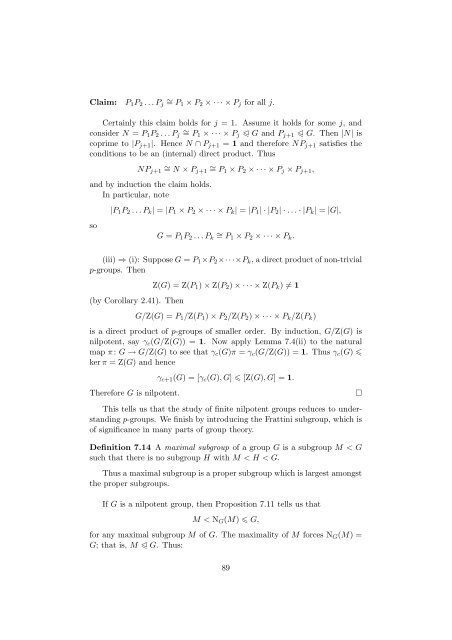You also want an ePaper? Increase the reach of your titles
YUMPU automatically turns print PDFs into web optimized ePapers that Google loves.
Claim: P 1 P 2 ...P j∼ = P1 × P 2 ×···×P j for all j.Certainly this claim holds for j =1. Assumeitholdsforsomej, andconsider N = P 1 P 2 ...P j∼ = P1 ×···×P j G and P j+1 G. Then |N| iscoprime to |P j+1 |. Hence N ∩ P j+1 = 1 and therefore NP j+1 satisfies theconditions to be an (internal) direct product. ThusNP j+1∼ = N × Pj+1 ∼ = P1 × P 2 ×···×P j × P j+1 ,and by induction the claim holds.In particular, note|P 1 P 2 ...P k | = |P 1 × P 2 ×···×P k | = |P 1 |·|P 2 |·...·|P k | = |G|,soG = P 1 P 2 ...P k∼ = P1 × P 2 ×···×P k .(iii) ⇒ (i): Suppose G = P 1 ×P 2 ×···×P k ,adirectproductofnon-trivialp-groups. Then(by Corollary 2.41). ThenZ(G) =Z(P 1 ) × Z(P 2 ) ×···×Z(P k ) ≠ 1G/Z(G) =P 1 /Z(P 1 ) × P 2 /Z(P 2 ) ×···×P k /Z(P k )is a direct product of p-groups of smaller order. By induction, G/Z(G) isnilpotent, say γ c (G/Z(G)) = 1. Now apply Lemma 7.4(ii) to the naturalmap π : G → G/Z(G) toseethatγ c (G)π = γ c (G/Z(G)) = 1. Thusγ c (G) ker π =Z(G) andhenceγ c+1 (G) =[γ c (G),G] [Z(G),G]=1.Therefore G is nilpotent.□This tells us that the study of finite nilpotent groups reduces tounderstandingp-groups. We finish by introducing the Frattini subgroup, which isof significance in many parts of group theory.Definition 7.14 A maximal subgroup of a group G is a subgroup M













